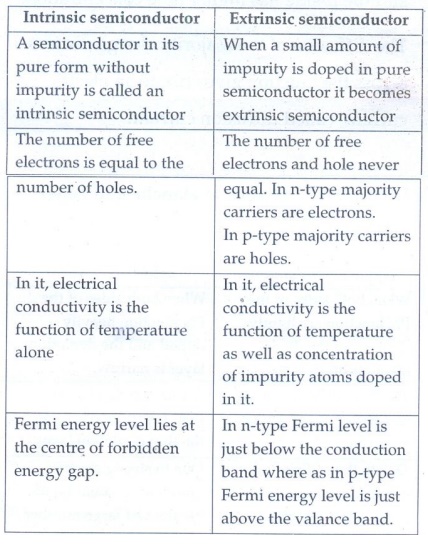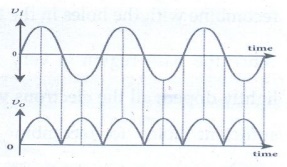Communication Systems | Physics - Short answers | 12th Physics : UNIT 10b : Communication Systems
Chapter: 12th Physics : UNIT 10b : Communication Systems
Short answers
II Short answers
22. What is modulation?
For long distance transmission, the low frequency baseband signal is superimposed onto a high frequency radio signal by a process called modulation.
23. Define bandwidth of transmission system.
The range of frequencies required to transmit a piece of specified information in a particular channel is called channel bandwidth or the bandwidth of the transmission system.
24. What is meant by skip distance and skip zone?
Skip Distance:
In the sky wave propagation the shortest distance between the point of transmission and the point of reception along the surface is known as the skip distance
Skip Zone / Skip area:
In sky wave propagation, there is a zone where there is no reception of electromagnetic waves neither ground nor sky, called as skip zone (or) skip area.
25. Give applications of RADAR.
i) In military, it is used for locating and detecting the targets.
ii) It is used in navigation systems such as ship borne surface search, air search and missile guidance systems.
iii) Radars are used to measure precipitation rate and wind speed in meteorological observations.
iv) It is employed to locate and rescue people in emergency situations.
26. What is mobile communication?
Mobile communication is used to communicate with others in different locations without the use of any physical connection like wires or cables.
27. Explain centre frequency or resting frequency in frequency modulation.
When the frequency of the baseband signal is zero, there is no change in the frequency of the carrier wave. It is at its normal frequency and is called as centre frequency or resting frequency.
28. What does RADAR stand for?
RADAR basically stands for Radio Detection And Ranging System
Short Answer Questions
1. Define forbidden energy gap.
The energy gap between the valence band and the conduction band is called forbidden energy gap.
2. Why is temperature co-efficient of resistance negative for semiconductor?
At a finite temperature, a semiconductor has very small electrical conductivity. When the temperature is increased further, more number of electrons are promoted to the conduction band and they increase the conduction.
Thus, the electrical conduction increases with the increase in temperature. In other words, resistance decreases with increase in temperature.
Hence, semiconductors have negative temperature coefficient of resistance.
3. What do you mean by doping?
The process of adding impurities to the intrinsic semiconductor is called doping.
It increases the concentration of charge carriers in the semiconductor. So, its electrical conductivity is increases.
The impurity atoms are called dopants.
4. Distinguish between intrinsic and extrinsic semiconductors.

Intrinsic semiconductor
• A semiconductor in its pure form without impurity is called an intrinsic semiconductor
• The number of free electrons is equal to the number of holes.
• In it, electrical conductivity is the function of temperature alone
• Fermi energy level lies at the centre of forbidden energy gap.
Extrinsic semiconductor
• When a small amount of impurity is doped in pure semiconductor it becomes extrinsic semiconductor
• The number of free electrons and hole never equal. In n-type majority carriers are electrons. In p-type majority carriers are holes.
• In it, electrical conductivity is the function of temperature as well as concentration of impurity atoms doped in it.
• In n-type Fermi level is just below the conduction band where as in p-type Fermi energy level is just above the valance band.
5. A diode is called as a unidirectional device.
Explain.
i) A dipole is unidirectional, ie. current flows in only one direction.
ii) When a forward bias is applied, the diode conducts, and when a reverse bias is applied, there is no conduction.
iii) Diode will conduct when the potential difference between the anode and the cathode exceeds the barrier voltage. 0.3V for Ge and 0.7V for Si.
6. What do you mean by leakage current in a diode?
Under reverse bias, a very small current in μA flows across the junction in a diode. This is due to the flow of minority charge carriers called leakage current (or) reverse saturation current.
7. Draw the output waveform of a full wave rectifier.

8. Distinguish between avalanche and Zener breakdown
Avalanche Breakdown
• When both sides of the PN junction are lightly doped and the depletion layer becomes large.
• The electric field across the depletion layer is not so strong.
• Due to the collision, covalent bonds are broken and electron hole pairs are generated.
• Reverse voltage must be greater than 6V
Zener breakdown
• When both sides of the PN junction heavily doped and the depletion Layer is narrow
• A very strong electric field is produced across the thin depletion layer.
• Due to strong electric field, the covalent bonds breaks and large number of electrons and holes are produced.
• Reverse voltage must be less than 4V
9. Give the Barkhausen conditions for sustained oscillations.
* The loop phase shift must be 0° or integral multiple of 2π
* The loop gain must be unity |Aβ| = 1
10. Explain the current flow in a NPN transistor.
i) In an NPN transistor, the majority carriers in the emitter are electrons.
ii) As it is heavily doped, it has a large number of electrons.
iii) The forward bias across the emitter base junction causes the electrons in the emitter region to flow towards the base region and constitutes the emitter current (IE).
iv) The electrons after reaching the base region recombine with the holes in the base region.
v) Since the base region is very narrow and lightly doped, all the electrons will not have sufficient holes to recombine and hence most of the electrons reach the collector region.
11. What are logic gates?
A logic gate is an electronic circuit whose function is based on digital signals They are binary in nature.
The logic gates are the basic building blocks of most of the digital systems.
They have one output with one or more inputs.
12. Explain the need for a feedback circuit in a transistor oscillator.
The circuit used to feedback, a portion of the output to the input is called the feedback network. If the portion of the output fed to the input is in phase with the input, then the magnitude of the input signal increases. It is necessary for sustained oscillations.
13. Write a short note on diffusion current across p-n junction.
Whenever p-n junction is formed, some of the free electrons diffuse from the n-side to the p-side while the holes from the p-side to the n side.
The diffusion of charge carriers happens due to the n-side has higher electron concentration and the p-side has higher hole concentration.
The diffusion of the majority charge carriers across the junction gives rise to an electric current, called diffusion current.
14. What is meant by biasing? Mention its types.
Biasing means providing external energy to charge carriers to overcome the barrier potential and make them move in a particular direction.
We have two types of biasing:
(i) Forward bias
(ii) Reverse bias
15. Why can't we interchange the emitter and collector even though they are made up of the same type of semiconductor material?
The emitter is more heavily doped than the collector and it is made physically smaller than the collector.
The collector is physically larger than the other two regions.
Because of the differing size and the amount of doping, the emitter and collector cannot be interchanged.
16. Why are NOR and NAND gates called universal gates?
NAND and NOR gates are known as universal gates because all other basic logic gates can be made from NAND or NOR gates.
17. Define barrier potential.
The difference in potential across the depletion layer is called the barrier potential.
At 25°C, this barrier potential is approximately 0.7V for silicon and 0.3V for germanium.
18. What is rectification?
The process in which alternating voltage or alternating current is converted into direct voltage or direct current is known as rectification.
The device used for this process is called as rectifier.
19. List the applications of Light Emitting Diode LED?
a) Indicator lamp
b) Seven segment display
c) Traffic signals, exit signs, emergency vehicle lighting etc...
d) Industrial process control, position encoders, bar graph readers.
20. Give the principle of solar cells.
A solar cell, also known as photovoltaic cell, works on the principle of photovoltaic effect.
Accordingly, the p-n junction of the solar cell generates emf when solar radiation falls on it.
21. What is an integrated circuit?
An integrated circuit consists of thousands to millions of transistors, resistors, capacitors integrated on a small flat piece of semiconductor material that is normally silicon.
It is also called as an IC or a chip or a microchip.
22. What is modulation?
For long distance transmission, the low frequency baseband signal is superimposed onto a high frequency radio signal by a process called modulation.
23. Define bandwidth of transmission system.
The range of frequencies required to transmit a piece of specified information in a particular channel is called channel bandwidth or the bandwidth of the transmission system.
24. What is meant by skip distance and skip zone?
Skip Distance:
In the sky wave propagation the shortest distance between the point of transmission and the point of reception along the surface is known as the skip distance
Skip Zone / Skip area:
In sky wave propagation, there is a zone where there is no reception of electromagnetic waves neither ground nor sky, called as skip zone (or) skip area.
25. Give applications of RADAR.
i) In military, it is used for locating and detecting the targets.
ii) It is used in navigation systems such as ship borne surface search, air search and missile guidance systems.
iii) Radars are used to measure precipitation rate and wind speed in meteorological observations.
iv) It is employed to locate and rescue people in emergency situations.
26. What is mobile communication?
Mobile communication is used to communicate with others in different locations without the use of any physical connection like wires or cables.
27. Explain centre frequency or resting frequency in frequency modulation.
When the frequency of the baseband signal is zero, there is no change in the frequency of the carrier wave. It is at its normal frequency and is called as centre frequency or resting frequency.
28. What does RADAR stand for?
RADAR basically stands for Radio Detection And Ranging System
Related Topics